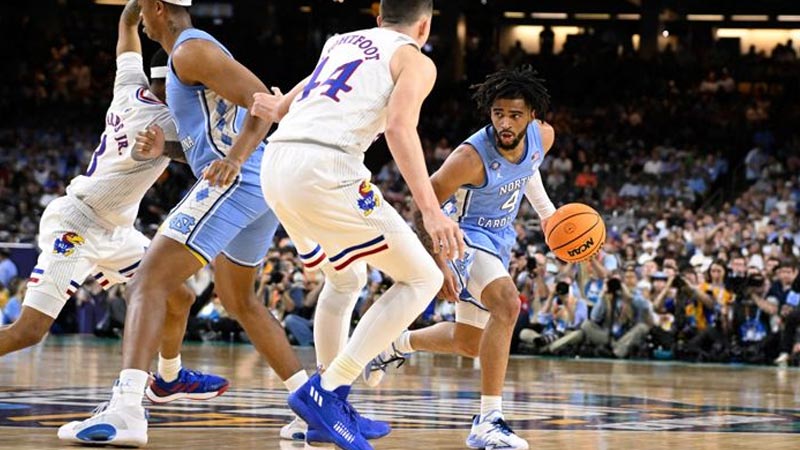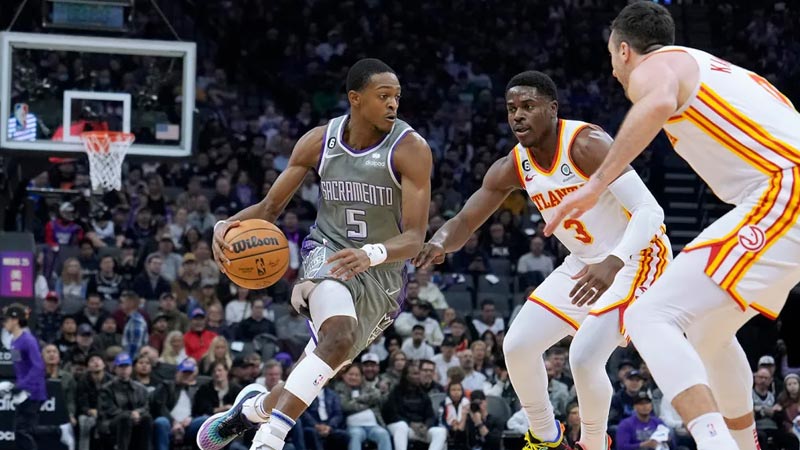Basketball is a dynamic sport where ball-handling skills are paramount to success on the court. Amidst the thrilling action and strategic plays, it’s essential to comprehend the various rules and violations that shape the game.
One such violation that can significantly impact gameplay is the carry. There are indeed different types of carrying Violation people often encounter.
In this blog post, we will delve into the intricacies of the carry violation in basketball, shedding light on its definition, and significance, and addressing common questions surrounding this often-misunderstood aspect of the game.
What Is A Carry In Basketball?
In basketball, “carry” refers to an illegal dribbling violation where a player allows the ball to come to rest in one hand while continuing to move or dribble with that hand. This violation is also known as “palming” or “carrying the ball.”
When a player carries the ball, it gives them an unfair advantage by allowing them to control the ball for longer than the permitted time.
According to the rules of basketball, a player must continuously dribble the ball by bouncing it off the floor with one hand while moving or changing direction. If the player fails to do so and the ball comes to a rest or if the hand is placed underneath the ball, it is considered a carry violation.
The referee will blow the whistle, and the opposing team is awarded possession of the ball through a turnover, or a foul is called.
Carrying the ball used to be a more common violation in the early days of basketball, but it is still enforced today to maintain fair play and prevent players from gaining an unfair advantage.
What Is Carrying Violation?

Source: basketballforcoaches.com
A carrying violation in basketball, also known as a “palming” violation or a “double dribble,” occurs when a player illegally holds or carries the ball while dribbling. It refers to a situation where a player’s hand is placed under the ball and provides excessive support or control during the dribbling motion.
According to the rules of basketball, a player must dribble the ball by continuously bouncing it off the floor with one hand while moving or changing direction. The hand must be on top of the ball and not underneath it.
If a player allows the ball to rest in one hand or if the hand is positioned so that it controls the ball excessively, it is considered a carrying violation.
A carrying violation typically results in a turnover, with the opposing team being awarded possession of the ball. The referee will blow the whistle, and play will stop to allow for the turnover.
In some cases, a carrying violation may also result in a personal foul if contact is made with an opposing player while carrying the ball.
It’s important to note that the interpretation and enforcement of carrying violations can vary slightly depending on the specific league or level of play. However, the fundamental principle remains the same: players must dribble the ball in a controlled manner without excessively carrying or palming it to maintain fair play and prevent an unfair advantage.
Types of Carrying Violation in Basketball
In basketball, there are different types of carrying violations that can occur. Here are a few common types:
Palm or Hand Underneath the Ball
This violation occurs when a player’s hand is placed underneath the ball while dribbling, providing excessive support or control. The hand should be on top of the ball during the dribble, and if it slides or stays underneath, it is considered a carrying violation.
Extended or Sustained Carry
This violation happens when a player allows the ball to come to rest in their hand while continuing to move or dribble with that hand. It involves a player maintaining prolonged contact with the ball, exceeding the permitted time for a legal dribble.
Change of Direction Carry
This violation occurs when a player changes their dribbling hand while carrying the ball. During a change of direction, if the player fails to keep their hand on top of the ball and allows it to rest or carry it, it results in a carrying violation.
Spin or Reverse Carry
This violation happens when a player uses a spin move or a reverse dribble but loses control of the ball while the hand is underneath or the ball is excessively controlled. It involves a player momentarily losing control due to improper hand placement.
These are just a few examples of carrying violations that can occur in basketball. It’s important for players to maintain proper hand position, avoid prolonged contact with the ball, and adhere to the rules regarding dribbling to prevent these violations and maintain fair play.
The specific interpretation and enforcement of carrying violations can vary slightly depending on the league or level of play.
How to Prevent a Carry in Basketball?

Source: fivethirtyeight.com
To prevent a carrying violation in basketball, players should focus on maintaining proper hand position and following the rules of dribbling. Here are some tips to help prevent carrying violations:
Hand Placement
Ensure that your hand is on top of the ball while dribbling. Avoid letting your hand slide underneath the ball, as this can lead to carrying. Keep your fingers spread and use your fingertips to control the ball during the dribble.
Control and Bounce
Use a controlled and consistent dribbling motion. The ball should be bounced off the floor with enough force so that it returns to your hand naturally. Avoid forcefully pushing the ball into the floor, as it can make it more difficult to control and increase the risk of carrying.
Timing and Speed
Maintain the proper rhythm and timing when dribbling. Be aware of the rules regarding the maximum amount of time you can control the ball during a dribble.
Avoid excessively palming or carrying the ball for an extended period. Practice dribbling at various speeds to develop better control.
Practice and Repetition
Regularly practice dribbling drills that focus on proper hand placement and control. Work on developing a strong dribbling technique that emphasizes using your fingertips and keeping your hand on top of the ball.
Repetition and muscle memory will help you develop better dribbling habits and reduce the likelihood of carrying violations.
Seek Feedback
Ask coaches, trainers, or experienced players to provide feedback on your dribbling technique. They can help identify any potential carrying habits and provide guidance on how to correct them. Incorporate their advice into your practice sessions to improve your dribbling skills.
By focusing on these techniques and practicing them consistently, you can develop better dribbling skills and reduce the risk of carrying violations in basketball.
Controversies with Carrying Violation in Basketball
While carrying violations in basketball are meant to maintain fair play and prevent an unfair advantage, there have been some controversies and debates surrounding their interpretation and enforcement. Here are a few controversies related to carrying violations
Inconsistent Enforcement
The interpretation and enforcement of carrying violations can vary between different leagues, levels of play, and even among referees.
This inconsistency can lead to confusion and frustration among players, coaches, and fans. Some argue that the rules should be clarified and standardized to ensure consistent enforcement.
Subjectivity in Interpretation
Carrying violations can be subjective in nature, as they depend on the referee’s judgment. What one referee might consider a carrying violation, another might interpret differently.
This subjectivity can lead to disagreements and debates about whether a violation was correctly called or not.
Gray Area with Crossover Dribbles
The rise in popularity of crossover dribbles, where a player quickly switches the ball from one hand to the other, has led to debates about carrying violations.
Some argue that these moves can border on carrying, as the ball may momentarily come to rest or be controlled excessively. Determining whether a crossover is legal or a carrying violation can be challenging and subjective.
Evolution of Dribbling Styles
As basketball evolves, players are continually developing new dribbling techniques and styles. Some of these styles may push the boundaries of traditional dribbling rules and raise questions about carrying violations.
This evolution can create a gray area where the rules may need to be adjusted or reevaluated to keep up with the game’s changing dynamics.
Impact on Offensive Flow
Strict enforcement of carrying violations can disrupt the offensive flow of the game. If referees consistently call carrying violations, it may result in more turnovers and slower gameplay.
Some argue that allowing slight variations in dribbling styles and being more lenient with carrying violations could help maintain the game’s pace and excitement.
It’s important to note that these controversies are not universally agreed upon, and different perspectives exist within the basketball community.
Ultimately, the rules and enforcement of carrying violations may continue to be a topic of discussion and potential refinement to strike a balance between fair play and the evolution of the game.
FAQs
What is a carry-in basketball?
A carry, also known as palming or carrying the ball, is an illegal dribbling violation in basketball. It occurs when a player holds or supports the ball excessively during the dribble, allowing the ball to come to rest in one hand or placing the hand underneath the ball.
Why is carrying considered a violation?
Carrying is deemed a violation to ensure fair play and prevent players from gaining an unfair advantage. Continuous dribbling with a single hand keeps the game flowing and allows defenders to anticipate and challenge the offense effectively.
What is a carrying violation called?
When a carrying violation occurs, the referee blows the whistle, stops play, and awards the opposing team possession of the ball. In some cases, a personal foul may be called if contact is made with an opponent while carrying the ball.
Are all carrying violations the same?
No, carrying violations can vary in nature. They can include situations where the hand is underneath the ball, the ball is excessively controlled or carried during a change of direction, or when a spin move results in a loss of control due to improper hand placement.
Are there any controversies surrounding carrying violations?
Carrying violations have sparked debates and controversies in basketball. Some argue for clearer and standardized enforcement, while others question the subjectivity of interpretation, especially with crossover dribbles.
There are ongoing discussions about balancing consistent enforcement with the evolution of dribbling styles and maintaining offensive flow.
Wrapping Up
The concept of carrying in basketball is crucial for players, coaches, and fans alike. It is a violation designed to maintain fairness and uphold the integrity of the game.
By adhering to the rules and regulations regarding dribbling, players can avoid carrying violations and ensure a smooth and exciting gameplay experience.
While controversies may arise regarding interpretation and enforcement, it remains important to respect the spirit of the rule while acknowledging the evolution of the sport.
So, the next time you hit the court, keep your dribbling crisp and within the boundaries of the game to avoid a carry violation.







